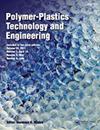新癸酸铋(III)的合成及其在聚氯乙烯热稳定中的应用
Q2 Materials Science
引用次数: 1
摘要
摘要采用氧化铋、新癸酸和乙酸酐共反应的方法合成了新癸酸铋(Bi(Ne)3),并用傅里叶变换红外光谱(FTIR)和元素分析(EA)对其进行了表征。通过热老化试验、刚果红试验、电导率测定和热重分析,分别评价了Bi(Ne)3作为热稳定剂对聚氯乙烯(PVC)的影响。结果表明,Bi(Ne)3对PVC具有良好的初始色和长期稳定性。Bi(Ne)3通过吸附氯化氢(HCl)和取代PVC分子链上的活性氯原子来提高PVC的稳定效率。图形抽象本文章由计算机程序翻译,如有差异,请以英文原文为准。
Synthesis of Bismuth(III)Neodecanoate and Its Application to Poly(Vinyl Chloride) as a Thermal Stabilizer
ABSTRACT The bismuth(III)neodecanoate (Bi(Ne)3) was synthesized via the method of co-reaction of bismuth oxide, neodecanoic acid, and acetic anhydride and then characterized by Fourier transform infrared spectroscopy (FTIR) and elemental analysis (EA). The effect of Bi(Ne)3 as a thermal stabilizer on poly(vinyl chloride) (PVC) was assessed by thermal aging test, Congo red test, conductivity measurement, and thermogravimetric analysis, respectively. The results showed that Bi(Ne)3 significantly provided PVC with a good initial color and long-term stability. Bi(Ne)3 played a role in improving the stabilizing efficiency of PVC through absorbing hydrogen chloride (HCl) and displacing labile chlorine atoms in PVC molecular chains. GRAPHICAL ABSTRACT
求助全文
通过发布文献求助,成功后即可免费获取论文全文。
去求助
来源期刊

Polymer-Plastics Technology and Engineering
工程技术-高分子科学
CiteScore
1.71
自引率
0.00%
发文量
0
审稿时长
4 months
 求助内容:
求助内容: 应助结果提醒方式:
应助结果提醒方式:


